8+ Sample Employee Weekly Report
-
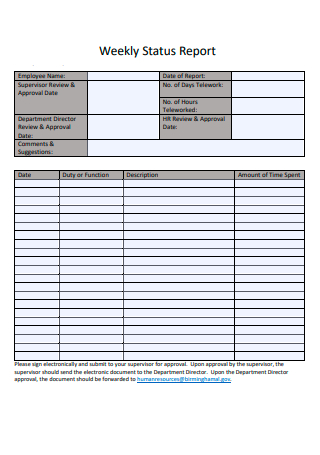
Employee Weekly Report Template
download now -
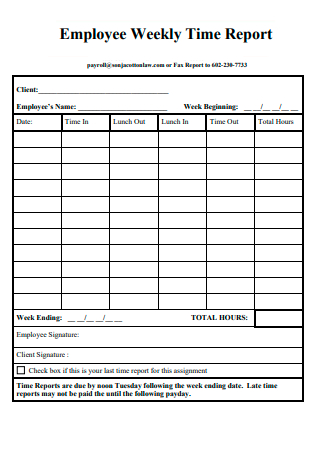
Employee Weekly Time Report
download now -
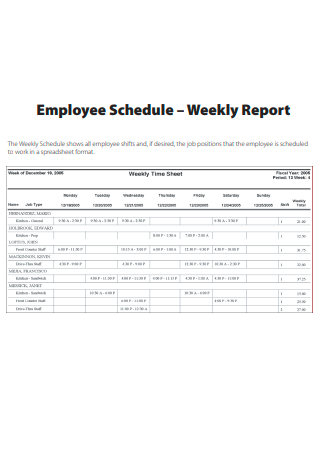
Employee Schedule Weekly Report
download now -
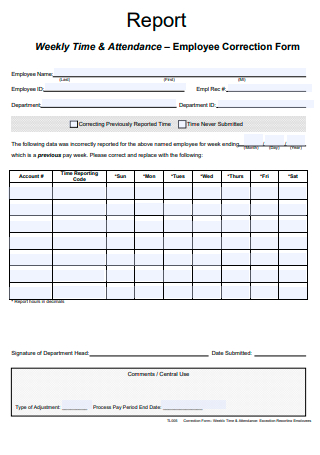
Employee Weekly Correction Form Report
download now -
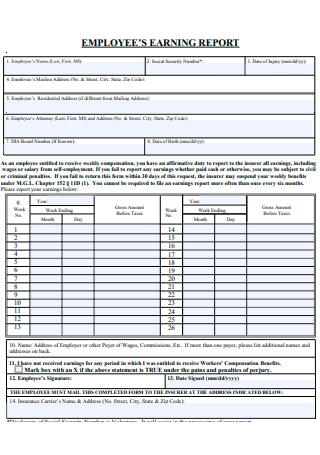
Employee Weekly Earning Report
download now -
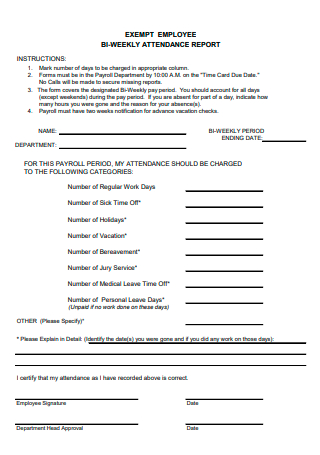
Employee Bi-Weekly Attendance Report
download now -
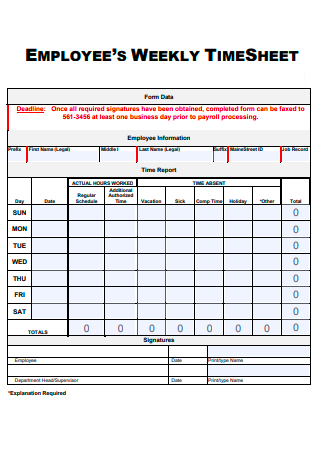
Employee Weekly Timesheet Report
download now -
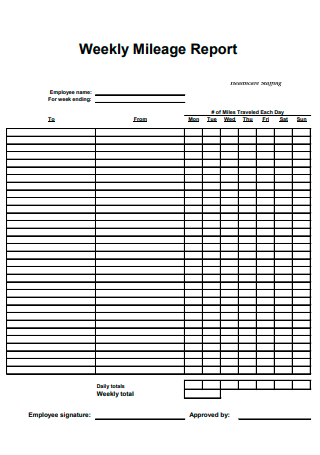
Employee Weekly Mileage Report
download now -
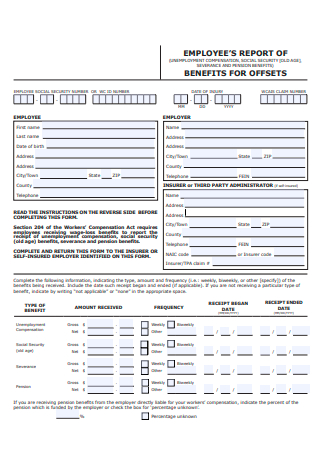
Formal Employee Weekly Report
download now
What Is a Weekly Report?
A weekly report reviews the previous week’s work and includes a summary of accomplished tasks, ongoing projects, and plans for the upcoming week’s workflow. Typically, weekly updates are brief and one page in length. Most professionals deliver weekly updates on Friday afternoons to maintain regular contact with team members and superiors. In addition, a weekly report can assist both you and your company by shedding light on significant areas of your completed work. According to statistics, 85% of employees are either not engaged or actively disengaged.
Benefits of Employee Weekly Report
Once you regularly submit a weekly report, you will discover several significant advantages. People use this strategy to arrange their work lives for various reasons, including saving time and lowering stress. It’s particularly effective for managers, as they can analyze the week in review for each team member. If you are still intrigued, here are a few of its advantageous features:
Tips for Writing a Weekly Report
In numerous vocations, writing reports is a primary duty. Doctors must compose medical reports detailing their evaluations of specific patients or cases. Knowing how to produce an effective report can make you a valued asset at your current job and an attractive prospect for a new one. Here are some guidelines for writing a report:
1. Establish terms of reference
Numerous formal reports contain a section describing the document’s “terms of reference.” Defining these terms assists both the author and the audience comprehend the report’s significance and objectives. Typically, the terms of reference are explained in the first paragraph so that the reader can determine their applicability without reading the entire document. Establishing concrete terms early on will help you create the report’s outline and keep your discussions on track as you write.
2. Perform your research
Most reports will require you to compile a corpus of data directly related to the issue. You may already have entry to this information, for instance, if you have copies of a patient’s medical records. If you are responsible for assessing a problem or researching an occurrence, you will likely need to request, locate, and organize data. A crucial aspect of preparing a report is interpreting data and arranging it so your audience can comprehend it. You may create charts, graphs, or timelines to simplify the comprehension of your raw data. To present it professionally, you will also need to meticulously reference your sources and track where and how you obtained the data.
3. Write an outline
The next step is to outline your report. This usually looks like a list of the document’s different parts with bullets or numbers. The type of report, how long it is, and how formal it needs to be will determine the order of these sections and whether or not you include them all. When writing your outline, the most important thing is to have all the necessary areas and eliminate anything that doesn’t directly help the report achieve its goal.
4. Write the first draft
The drafting of initial draft is one of the most crucial steps in the construction of an excellent report. The first draft aims not to produce flawless text but to get all necessary material out of your head and onto paper. Your primary objective should be to organize your facts and analysis into a rough draft that will eventually become the final output. During the writing of your first draft, you will likely discover data or analysis gaps. Please take note of these, but do not attempt to address all of them in your writing. Instead, complete the first draft and keep problem-solving for the editing stage.
5. Analyze data and document results
Every report is centered on the “findings” section, where you offer your interpretation of the facts. The results may explain why a company’s stock fell for a certified public accountant during the preceding quarter. For an environmental scientist, this could include a synopsis of an experiment with biodegradable polymers and a discussion of how the results may impact waste management techniques. Even if the outcomes are less than ideal, the findings part of your report should always contain relevant information about the topic or issue you are addressing. If you conclude that the data was insufficient or the study methodology was incorrect, you must express this professionally and factually.
6. Recommend a course of action
Your recommendation concludes the body of your report. After studying the data and assessing the results, you are qualified to propose a course of action in light of your findings. A project manager may advocate adding an employee to the team, for instance, after assessing the overtime hours their team has been working. After observing an increase in preventable infections over the past six months, a surgeon may recommend that the hospital implement new sterilizing techniques in the operating room.
7. Edit and distribute
The final step in writing a report is rigorous editing and distribution to the intended audience. You will need to edit for grammar, spelling, and typographical issues. You must also double-check your facts, ensure that your sources are accurate, and review the overall paper to provide a unified story. If a large audience views the report, you may wish to have someone else edit it or provide feedback on the content’s readability. Depending on your occupation, there are various methods for disseminating the report. It might be emailed to your boss, presented verbally at a staff meeting, or published in a professional magazine. Your goal should always be to develop short, informative, and compelling content that contributes to enhanced workplace productivity, regardless of how or where it is read.
How to Be a Good Employee
While explaining the characteristics of an excellent employee can be challenging, describing the benefits is simple. Good employees receive raises, promotions, and accolades from their superiors. She is frequently a role model for her colleagues, is chosen for innovative projects, and makes work appear effortless. However, what does it mean to be an excellent employee? And what talents can you build to ensure that you are regarded as a good, or perhaps a great, employee at your own company? Let’s dive in.
Step 1: A growing mentality and a desire to learn
A competent worker’s willingness to learn and a growth attitude are two essential qualities. You have a growth perspective if you feel you can build and polish talents and improve over time. Also, a fixed mindset believes one’s intelligence and abilities are innate and immutable. Even if she has a creative background, a marketer with a growth mentality may elect to take a few analytics courses to enhance data-related skills in the field. A growth mindset can affect an employee’s motivation, work ethic, and receptivity to constructive criticism. This mentality permits people to thrive during the most challenging moments of their lives.
Step 2: A cheerful and solution-oriented outlook
Employees prefer working with individuals that are optimistic and solution-oriented when obstacles arise. Working with someone who focuses on the bad or demotivates the rest of the team can be frustrating. At a previous job, I worked with an individual who felt disappointed in his position. A positive attitude can motivate others to work harder and boost your team’s morale when faced with a tough challenge. Moreover, happiness is associated with increased success. Research shows that happy workers are up to 20% more productive than dissatisfied employees, and content sales clerks generate 37% more revenue than their unhappy counterparts. An optimistic outlook also facilitates a quicker transition to a solutions-oriented mindset. For instance, negativity may cause you to feel frustrated when you encounter an obstacle. You may rely on self-blame, criticism, or a lack of enthusiasm to change your technique. However, a good attitude can help you remain confident, calm, and level-headed when facing a challenge. Positivity can help you reframe the situation by saying, “This obstacle is an opportunity for us to rethink our plan and develop a better solution.” Everyone is entitled to terrible days, but a successful employee does not let their bad mood interfere with problem-solving or team morale.
Step 3: Empathy and emotional intelligence
Emotional intelligence is a crucial competency for employees and leaders to cultivate. In the job, the capacity to control one’s emotions and those of others have proven essential. Consider asking coworkers how they’re doing to practice empathy in the office and hone your active listening skills to build rapport over time. For example, if a coworker notes that he will be celebrating his birthday this weekend, follow up and inquire how the celebration went. In addition, take the time to comprehend how your products or services suit the demands of your clients. Imagine yourself in their position. Listen to customer interviews or read survey results to gain a deeper understanding of your customers’ concerns, automatically leading to greater customer empathy.
Step 4: Accountability
Being accountable only entails accepting responsibility for one’s actions, a talent crucial in the workplace. People make errors daily; what matters is how you respond to them. Go immediately to your manager and explain how your actions may have caused or contributed to the problem. Furthermore, it is commendable if you take the time to self-reflect and explore how you might alter your approach to achieve your goals the next time. If you are responsible for publishing 12 blog entries per month but only manage to accomplish 10, you will need to determine what hindered you from meeting your objective. Then, when you contact your manager, you can say something like, “I had trouble with the final two parts because I failed to adequately estimate how long each would take, especially the pieces that required external quotes.”
Step 5: Critical, big-picture thinking
A good employee always ensures that his job corresponds with the company’s goals and positively impacts the company’s bottom line by pausing to reflect on the broader picture. It’s never too early to ask queries and take an interest in the wider business, even if you’ve just begun at a new employer. A successful employee demonstrates strategic, big-picture thinking, and your manager will notice if you take the time to consider how the challenges or tasks at hand fit into the company’s overall strategy.
Step 6: Ambition
Ambition can take many forms, but in this context, we’re discussing the purpose of scalability. A good employee examines how she may maximize her contribution to the organization. She also thinks about how she may establish new processes to facilitate the outputs of her entire team. When assuming a new position, take the time to investigate inefficiencies or little things that could cause problems as the organization grows. These challenges could create avenues for expansion.
Step 7: Good communication skills
An excellent employee is also clear and direct with coworkers. She employs practical communication skills, such as attentive listening, establishing clear expectations, posing pertinent questions, and demonstrating interest in what the other person is saying. We’ve all worked with coworkers who don’t appear when talking or fail to follow through on commitments. It is aggravating and can erode trust. A good employee practices practical communication skills daily in-person and online. A skilled employee can also clarify when she can and cannot accept extra responsibilities. This is a component of setting expectations.
FAQs
Is a weekly report necessary?
Weekly reports are essential for managing the success of your staff. You can track work status changes and progress, employee productivity, and key performance indicators using weekly reports. As more people work remotely, preventing coronavirus transmission is more critical than ever.
What is a weekly and monthly report?
In contrast to annual reports (which are generic) and weekly reports (which are detailed), monthly reports provide a marketing-relevant review of information for a few weeks.
What is a formal report example?
A formal report is an authorized report containing the relevant information, research, and data for making business choices. Examples include annual, cost, incident, and even safety reports.
Do you have to compose a weekly report? It is not simple to write a clear and appealing weekly update. It involves considerable effort and labor. We have tons of ready-made weekly report templates to assist you in getting started. So, download and customize our free employee weekly report template today!
